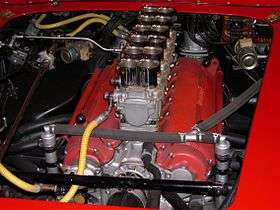Carburetor
A carburetor (American English) or carburettor (British English) is a device that mixes air and fuel for internal combustion engines in the proper air–fuel ratio for combustion. It is sometimes colloquially shortened to carb in the UK and North America or carby in Australia.[1] To carburate or carburet (and thus carburation or carburetion, respectively) means to mix the air and fuel or to equip (an engine) with a carburetor for that purpose.
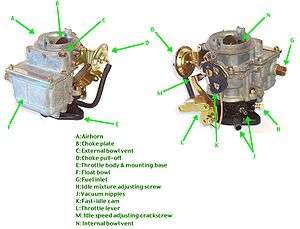
Carburetors have largely been supplanted in the automotive and, to a lesser extent, aviation industries by fuel injection. They are still common on small engines for lawn mowers, rototillers and other equipment.
Etymology
The word carburetor comes from the French carbure meaning "carbide".[2][3] Carburer means to combine with carbon (compare also carburizing). In fuel chemistry, the term has the more specific meaning of increasing the carbon (and therefore energy) content of a fluid by mixing it with a volatile hydrocarbon.
History and development
The first carburetor was invented by Samuel Morey in 1826. The first person to patent a carburetor for use in a petroleum engine was Siegfried Marcus with his 6 July 1872 patent for a device which mixes fuel with air.
A carburetor was among the early patents by Karl Benz (1888)[4] as he developed internal combustion engines and their components.[5]
Early carburetors were of the surface type, in which air is combined with fuel by passing over the surface of gasoline.[6]
In 1885, Wilhelm Maybach and Gottlieb Daimler developed a float carburetor based on the atomizer nozzle.[7] The Daimler-Maybach carburetor was copied extensively, leading to patent lawsuits. British courts rejected the Daimler company's claim of priority in favor of Edward Butler's 1884 spray carburetor used on his Petrol Cycle.[8]
Hungarian engineers János Csonka and Donát Bánki patented a carburetor for a stationary engine in 1893.[9][10][11]
Frederick William Lanchester of Birmingham, England, experimented with the wick carburetor in cars. In 1896, Frederick and his brother built a gasoline-driven car in England, a single cylinder 5 hp (3.7 kW) internal combustion engine with chain drive. Unhappy with the car's performance and power, they re-designed the engine the following year using two horizontally-opposed cylinders and a newly designed wick carburetor.
Carburetors were the common method of fuel delivery for most US-made gasoline engines until the late 1980s, when fuel injection became the preferred method.[12] This change was dictated by the requirements of catalytic converters and not due to an inherent inefficiency of carburation. A catalytic converter requires that there be more precise control over the fuel/air mixture in order to control the amount of oxygen remaining in the exhaust gases. In the U.S. market, the last cars using carburetors were:
- 1990 (General public) : Oldsmobile Custom Cruiser, Buick Estate Wagon, Cadillac Brougham, Honda Prelude (Base Model), Subaru Justy
- 1991 (Police) : Ford Crown Victoria Police Interceptor with the 5.8 L (351 cu in) V8 engine.
- 1991 (SUV) : Jeep Grand Wagoneer with the AMC 360 cu in (5.9 L) V8 engine.[13]
- 1993 (Light Truck) : Mazda B2200
- 1994 (Light truck) : Isuzu[14]
In Australia, some cars continued to use carburetors well into the 1990s; these included the Honda Civic (1993), the Ford Laser (1994), the Mazda 323 and Mitsubishi Magna sedans (1996), the Daihatsu Charade (1997), and the Suzuki Swift (1999). Low-cost commercial vans and 4WDs in Australia continued with carburetors even into the 2000s, the last being the Mitsubishi Express van in 2003. Elsewhere, certain Lada cars used carburetors until 2006. Many motorcycles still use carburetors for simplicity's sake, since a carburetor does not require an electrical system to function. Carburetors are also still found in small engines and in older or specialized automobiles, such as those designed for stock car racing, though NASCAR's 2011 Sprint Cup season was the last one with carbureted engines; electronic fuel injection was used beginning with the 2012 race season in Cup.[15]
In Europe, carburetor-engined cars were being gradually phased out by the end of the 1980s in favor of fuel injection, which was already the established type of engine on more expensive vehicles including luxury and sports models. EEC legislation required all vehicles sold and produced in member countries to have a catalytic converter after December 1992. This legislation had been in the pipeline for some time, with many cars becoming available with catalytic converters or fuel injection from around 1990. However, some versions of the Peugeot 106 were sold with carburetor engines from its launch in 1991, as were versions of the Renault Clio and Nissan Primera (launched in 1990) and initially all versions of Ford Fiesta range except the XR2i when it was launched in 1989. Luxury car manufacturer Mercedes-Benz had been producing mechanically fuel-injected cars since the early 1950s, while the first mainstream family car to feature fuel injection was the Volkswagen Golf GTI in 1976. Ford's first fuel-injected car was the Ford Capri RS 2600 in 1970. General Motors launched its first fuel-injected car in 1957 as an option available for the first generation Corvette. Saab switched to fuel injection across its whole range from 1982, but keeping carbureted engines as an option on certain models until 1989.
Principles
The carburetor works on Bernoulli's principle: the faster air moves, the lower its static pressure, and higher the dynamic pressure is. The throttle (accelerator) linkage does not directly control the flow of liquid fuel. Instead, it actuates carburetor mechanisms which meter the flow of air being carried into the engine. The speed of this flow, and therefore its (static) pressure, determines the amount of fuel drawn into the airstream.
When carburetors are used in aircraft with piston engines, special designs and features are needed to prevent fuel starvation during inverted flight. Later engines used an early form of fuel injection known as a pressure carburetor.
Most production carbureted engines, as opposed to fuel-injected, have a single carburetor and a matching intake manifold that divides and transports the air/fuel mixture to the intake valves, though some engines (like motorcycle engines) use multiple carburetors on split heads. Multiple carburetor engines were also common enhancements for modifying engines in the USA from the 1950s to mid-1960s, as well as during the following decade of high-performance muscle cars, each carburetor feeding different chambers of the engine's intake manifold.
Older engines used updraft carburetors, where the air enters from below the carburetor and exits through the top. This had the advantage of never flooding the engine, as any liquid fuel droplets would fall out of the carburetor instead of into the intake manifold; it also lent itself to use of an oil bath air cleaner, where a pool of oil below an element below the carburetor is sucked up into the mesh and the air is drawn through the oil-covered mesh; this was an effective system in a time when paper air filters did not exist.
Beginning in the late 1930s, downdraft carburetors were the most popular type for automotive use in the United States. In Europe, the sidedraft carburetor replaced downdraft as free space in the engine bay decreased and the use of the SU-type carburetor (and similar units from other manufacturers) increased. Some small propeller-driven aircraft engines still use the updraft carburetor design.
Outboard motor carburetors are typically sidedraft, because they must be stacked one on top of the other in order to feed the cylinders in a vertically oriented cylinder block.
The main disadvantage of basing a carburetor's operation on Bernoulli's Principle is that, being a fluid dynamic device, the pressure reduction in a venturi tends to be proportional to the square of the intake airspeed. The fuel jets are much smaller and fuel flow is limited mainly by the fuel's viscosity, so that the fuel flow tends to be proportional to the pressure difference. So jets sized for full power tend to starve the engine at lower speed and part throttle. Most commonly this has been corrected by using multiple jets. In SU and other variable jet carburetors, it was corrected by varying the jet size. For cold starting, a different principle was used in multi-jet carburetors. An airflow resisting valve called a choke, similar to the throttle valve, was placed upstream of the main jet to reduce the intake manifold pressure and suck additional fuel out of the jets.
Operation
- Fixed-venturi
- Varying air velocity in the venturi controls the fuel flow; the most common type of carburetor found on cars.
- Variable-venturi
- The fuel jet opening is varied by the slide (which simultaneously alters air flow). In "constant depression" carburetors, this is done by a vacuum operated piston connected to a tapered needle that slides inside the fuel jet. A simpler version exists, most commonly found on small motorcycles and dirt bikes, where the slide and needle are directly controlled by the throttle position. The most common variable venturi (constant depression) type carburetor is the sidedraft SU carburetor and similar models from Hitachi, Zenith-Stromberg and other makers. The UK location of the SU and Zenith-Stromberg companies helped these carburetors rise to a position of domination in the UK car market, though such carburetors were also very widely used on Volvos and other non-UK makes. Other similar designs have been used on some European and a few Japanese automobiles. These carburetors are also referred to as "constant velocity" or "constant vacuum" carburetors. An interesting variation was Ford's VV (variable venturi) carburetor, which was essentially a fixed venturi carburetor with one side of the venturi hinged and movable to give a narrow throat at low rpm and a wider throat at high rpm. This was designed to provide good mixing and airflow over a range of engine speeds, though the VV carburetor proved problematic in service.
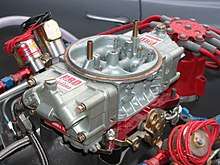
Under all engine operating conditions, the carburetor must:
- Measure the airflow of the engine
- Deliver the correct amount of fuel to keep the fuel/air mixture in the proper range (adjusting for factors such as temperature)
- Mix the two finely and evenly
This job would be simple if air and gasoline (petrol) were ideal fluids; in practice, however, their deviations from ideal behavior due to viscosity, fluid drag, inertia, etc. require a great deal of complexity to compensate for exceptionally high or low engine speeds. A carburetor must provide the proper fuel/air mixture across a wide range of ambient temperatures, atmospheric pressures, engine speeds and loads, and centrifugal forces including the following scenarios;
- Cold start
- Hot start
- Idling or slow-running
- Acceleration
- High speed / high power at full throttle
- Cruising at part throttle (light load)
In addition, modern carburetors are required to do this while maintaining low levels of exhaust emissions.
To function correctly under all these conditions, most carburetors contain a complex set of mechanisms to support several different operating modes, called circuits.
Basics
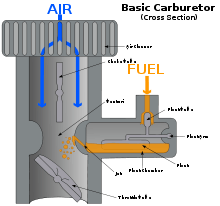
A carburetor consists of an open pipe through which the air passes into the inlet manifold of the engine. The pipe is in the form of a venturi: it narrows in section and then widens again, causing the airflow to increase in speed in the narrowest part. Below the venturi is a butterfly valve called the throttle valve — a rotating disc that can be turned end-on to the airflow, so as to hardly restrict the flow at all, or can be rotated so that it (almost) completely blocks the flow of air. This valve controls the flow of air through the carburetor throat and thus the quantity of air/fuel mixture the system will deliver, thereby regulating engine power and speed. The throttle is connected, usually through a cable or a mechanical linkage of rods and joints or rarely by pneumatic link, to the accelerator pedal on a car, a throttle lever in an aircraft or the equivalent control on other vehicles or equipment.
Fuel is introduced into the air stream through small holes at the narrowest part of the venturi and at other places where pressure will be lowered when not running at full throttle. Fuel flow is adjusted by means of precisely calibrated orifices, referred to as jets, in the fuel path.
Off-idle circuit
As the throttle valve is opened slightly from the fully closed position, the throttle plate uncovers additional fuel delivery holes behind the throttle plate where there is a low pressure area created by the throttle plate/Valve blocking the air flow; these allow more fuel to flow as well as compensating for the reduced vacuum that occurs when the throttle is opened, thus smoothing the transition to metered fuel flow through the regular open throttle circuit.
Main open-throttle circuit
As the throttle valve is progressively opened, the manifold vacuum is lessened since there is less restriction of the airflow, reducing the fuel flow through the idle and off-idle circuits. This is when the venturi shape of the carburetor throat comes into play, due to Bernoulli's principle (i.e., as the velocity increases, pressure falls). The venturi increases the air velocity, and this higher speed and thus lower pressure sucks fuel into the airstream through a nozzle or nozzles located in the center of the venturi. Sometimes one or more additional booster venturis are placed coaxially within the primary venturi to increase the effect.
As the throttle valve is closed, the airflow through the venturi drops until the lowered pressure is insufficient to maintain the fuel flow, and the off-idle circuits take over again, as described above.
Bernoulli's principle, which is a function of the velocity of the fluid, is the dominant effect for large openings and large flow rates, but since fluid flow at small scales and low speeds (low Reynolds number) is dominated by viscosity, Bernoulli's principle is ineffective at idle or slow speeds and also in the very small carburetors of the smallest model engines. Small model engines have flow restrictions ahead of the jets to reduce the pressure enough to suck the fuel into the air flow. Similarly the idle and slow running jets of large carburetors are placed after the throttle valve where the pressure is reduced partly by viscous drag, rather than by Bernoulli's principle. The most common rich mixture producing device for starting cold engines is the choke, which works on the same principle.
Power valve
For open throttle operation a richer fuel/air mixture will produce more power, prevent pre-ignition detonation, and keep the engine running cooler. This is usually addressed with a spring-loaded "power valve", which is held shut by engine vacuum. As the throttle valve opens up, the manifold vacuum decreases and the spring opens the valve to let more fuel into the main circuit. On two-stroke engines, the operation of the power valve is the reverse of normal — it is normally "on" and at a set rpm it is turned "off". It is activated at high rpm to extend the engine's rev range, capitalizing on a two-stroke's tendency to rev higher momentarily when the mixture is lean.
Alternately to employing a power valve, the carburetor may utilize a metering rod or step-up rod system to enrich the fuel mixture under high-demand conditions. Such systems were originated by Carter Carburetor in the 1950s for the primary two venturis of their four barrel carburetors, and step-up rods were widely used on most 1-, 2-, and 4-barrel Carter carburetors through the end of production in the 1980s. The step-up rods are tapered at the bottom end, which extends into the main metering jets. The tops of the rods are connected to a vacuum piston or a mechanical linkage which lifts the rods out of the main jets when the throttle is opened (mechanical linkage) or when manifold vacuum drops (vacuum piston). When the step-up rod is lowered into the main jet, it restricts the fuel flow. When the step-up rod is raised out of the jet, more fuel can flow through it. In this manner, the amount of fuel delivered is tailored to the transient demands of the engine. Some 4-barrel carburetors use metering rods only on the primary two venturis, but some use them on both primary and secondary circuits, as in the Rochester Quadrajet.
Accelerator pump
Liquid gasoline, being denser than air, is slower than air to react to a force applied to it. When the throttle is rapidly opened, airflow through the carburetor increases immediately, faster than the fuel flow rate can increase. Also the air pressure in the manifold increases, decreasing the evaporation of the fuel, so less fuel vapour is sucked into the engine. This transient oversupply of air relative to the fuel causes a lean mixture, which makes the engine misfire (or "stumble")—an effect opposite to that which was demanded by opening the throttle. This is remedied by the use of a small piston or diaphragm pump which, when actuated by the throttle linkage, forces a small amount of gasoline through a jet into the carburetor throat.[16] This extra shot of fuel counteracts the transient lean condition on throttle tip-in. Most accelerator pumps are adjustable for volume or duration by some means. Eventually, the seals around the moving parts of the pump wear such that the pump output is reduced; this reduction of the accelerator pump shot causes stumbling under acceleration until the seals on the pump are renewed.
The accelerator pump can also be used to prime the engine with fuel prior to a cold start. Excessive priming, like an improperly adjusted choke, can cause flooding. This is when too much fuel and not enough air are present to support combustion. For this reason, most carburetors are equipped with an unloader mechanism: The accelerator is held at wide open throttle while the engine is cranked, the unloader holds the choke open and admits extra air, and eventually the excess fuel is cleared out and the engine starts.
Choke
When the engine is cold, fuel vaporizes less readily and tends to condense on the walls of the intake manifold, starving the cylinders of fuel and making the engine difficult to start; thus, a richer mixture (more fuel to air) is required to start and run the engine until it warms up. A richer mixture is also easier to ignite.
To provide the extra fuel, a choke is typically used; this is a device that restricts the flow of air at the entrance to the carburetor, before the venturi. With this restriction in place, extra vacuum is developed in the carburetor barrel, which pulls extra fuel through the main metering system to supplement the fuel being pulled from the idle and off-idle circuits. This provides the rich mixture required to sustain operation at low engine temperatures.
In addition, the choke can be connected to a cam (the fast idle cam) or other such device which prevents the throttle plate from closing fully while the choke is in operation. This causes the engine to idle at a higher speed. Fast idle serves as a way to help the engine warm up quickly, and give a more stable idle by increasing airflow throughout the intake system which helps to better atomize the cold fuel.
In older carbureted cars, the choke was controlled manually by a Bowden cable and pull-knob on the dashboard. For easier, more convenient driving, automatic chokes; first introduced in the 1932 Oldsmobile, became popular in the late 1950s. These were controlled by a thermostat employing a bimetallic spring. When cold, the spring would contract, closing the choke plate. Upon startup, the spring would be heated by engine coolant, exhaust heat or an electric heating coil. As it was heated, the spring would slowly expand and open the choke plate. A choke unloader is a linkage arrangement that forces the choke open against its spring when the vehicle's accelerator is moved to the end of its travel. This provision allows a "flooded" engine to be cleared out so that it will start.
Forgetting to deactivate the choke once the engine achieved operating temperature would waste fuel and increase emissions. To meet increasingly stringent emission requirements, some cars that still retained manual chokes (from around 1980, depending on market) began to have choke opening automatically controlled by a thermostat employing a bimetallic spring, heated by the engine coolant.
The 'choke' for constant-depression carburetors such as the SU or Stromberg does not use a choke valve in the air circuit but instead has a mixture enrichment circuit to increase fuel flow by opening the metering jet further or by opening an additional fuel jet for 'enrichment'. Typically used on small engines, notably motorcycles, enrichment works by opening a secondary fuel circuit below the throttle valves. This circuit works exactly like the idle circuit, and when engaged it simply supplies extra fuel when the throttle is closed.
Classic British motorcycles, with side-draft slide-throttle carburetors, used another type of "cold start device", called a "tickler". This is simply a spring-loaded rod that, when depressed, manually pushes the float down and allows excess fuel to fill the float bowl and flood the intake tract. If the "tickler" is held down too long it also floods the outside of the carburetor and the crankcase below, and is therefore a fire hazard.
Other elements
The interactions between each circuit may also be affected by various mechanical or air pressure connections and also by temperature sensitive and electrical components. These are introduced for reasons such as engine responsiveness, fuel efficiency or automobile emissions control. Various air bleeds (often chosen from a precisely calibrated range, similarly to the jets) allow air into various portions of the fuel passages to enhance fuel delivery and vaporization. Extra refinements may be included in the carburetor/manifold combination, such as some form of heating to aid fuel vaporization such as an early fuel evaporator.
Fuel supply
Float chamber
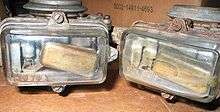
To ensure a ready mixture, the carburetor has a "float chamber" (or "bowl") that contains a quantity of fuel at near-atmospheric pressure, ready for use. This reservoir is constantly replenished with fuel supplied by a fuel pump. The correct fuel level in the bowl is maintained by means of a float controlling an inlet valve, in a manner very similar to that employed in a cistern (e.g. a toilet tank). As fuel is used up, the float drops, opening the inlet valve and admitting fuel. As the fuel level rises, the float rises and closes the inlet valve. The level of fuel maintained in the float bowl can usually be adjusted, whether by a setscrew or by something crude such as bending the arm to which the float is connected. This is usually a critical adjustment, and the proper adjustment is indicated by lines inscribed into a window on the float bowl, or a measurement of how far the float hangs below the top of the carburetor when disassembled, or similar. Floats can be made of different materials, such as sheet brass soldered into a hollow shape, or of plastic; hollow floats can spring small leaks and plastic floats can eventually become porous and lose their flotation; in either case the float will fail to float, fuel level will be too high, and the engine will not run unless the float is replaced. The valve itself becomes worn on its sides by its motion in its "seat" and will eventually try to close at an angle, and thus fails to shut off the fuel completely; again, this will cause excessive fuel flow and poor engine operation. Conversely, as the fuel evaporates from the float bowl, it leaves sediment, residue, and varnishes behind, which clog the passages and can interfere with the float operation. This is particularly a problem in automobiles operated for only part of the year and left to stand with full float chambers for months at a time; commercial fuel stabilizer additives are available that reduce this problem.
The fuel stored in the chamber (bowl) can be a problem in hot climates. If the engine is shut off while hot, the temperature of the fuel will increase, sometimes boiling ("percolation"). This can result in flooding and difficult or impossible restarts while the engine is still warm, a phenomenon known as "heat soak". Heat deflectors and insulating gaskets attempt to minimize this effect. The Carter Thermo-Quad carburetor has float chambers manufactured of insulating plastic (phenolic), said to keep the fuel 20 degrees Fahrenheit (11 degrees Celsius) cooler.
Usually, special vent tubes allow atmospheric pressure to be maintained in the float chamber as the fuel level changes; these tubes usually extend into the carburetor throat. Placement of these vent tubes is critical to prevent fuel from sloshing out of them into the carburetor, and sometimes they are modified with longer tubing. Note that this leaves the fuel at atmospheric pressure, and therefore it cannot travel into a throat which has been pressurized by a supercharger mounted upstream; in such cases, the entire carburetor must be contained in an airtight pressurized box to operate. This is not necessary for installations where the carburetor is mounted upstream of the supercharger, which is for this reason the more frequent system. However, this results in the supercharger being filled with compressed fuel/air mixture, with a strong tendency to explode should the engine backfire; this type of explosion is frequently seen in drag races, which for safety reasons now incorporate pressure releasing blow-off plates on the intake manifold, breakaway bolts holding the supercharger to the manifold, and shrapnel-catching ballistic blankets made from nylon or kevlar surrounding the superchargers.
Diaphragm chamber
If the engine must be operated in any orientation (for example a chain saw or a model airplane), a float chamber is not suitable. Instead, a diaphragm chamber is used. A flexible diaphragm forms one side of the fuel chamber and is arranged so that as fuel is drawn out into the engine, the diaphragm is forced inward by ambient air pressure. The diaphragm is connected to the needle valve and as it moves inward it opens the needle valve to admit more fuel, thus replenishing the fuel as it is consumed. As fuel is replenished the diaphragm moves out due to fuel pressure and a small spring, closing the needle valve. A balanced state is reached which creates a steady fuel reservoir level, which remains constant in any orientation.
Multiple carburetor barrels
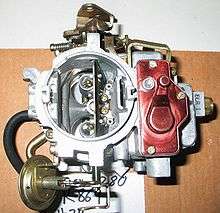
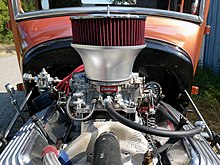
While basic carburetors have only one venturi, many carburetors have more than one venturi, or "barrel". Two barrel and four barrel configurations are commonly used to accommodate the higher air flow rate with large engine displacement. Multi-barrel carburetors can have non-identical primary and secondary barrel(s) of different sizes and calibrated to deliver different air/fuel mixtures; they can be actuated by the linkage or by engine vacuum in "progressive" fashion, so that the secondary barrels do not begin to open until the primaries are almost completely open. This is a desirable characteristic which maximizes airflow through the primary barrel(s) at most engine speeds, thereby maximizing the pressure "signal" from the venturis, but reduces the restriction in airflow at high speeds by adding cross-sectional area for greater airflow. These advantages may not be important in high-performance applications where part throttle operation is irrelevant, and the primaries and secondaries may all open at once, for simplicity and reliability; also, V-configuration engines, with two cylinder banks fed by a single carburetor, may be configured with two identical barrels, each supplying one cylinder bank. In the widely seen V8 and 4-barrel carburetor combination, there are often two primary and two secondary barrels.
The first four-barrel carburetors, with two primary bores and two secondary bores, were the Carter WCFB and identical Rochester 4GC simultaneously introduced on the 1952 Cadillacs, Oldsmobile 98, Oldsmobile Super 88 and Buick Roadmaster. Oldsmobile referred the new carburetor as the “Quadri-Jet” (original spelling)[17] while Buick called it the “Airpower”.[18]
The spread-bore four-barrel carburetor, first released by Rochester in the 1965 model year as the "Quadrajet" has a much greater spread between the sizes of the primary and secondary throttle bores. The primaries in such a carburetor are quite small relative to conventional four-barrel practice, while the secondaries are quite large. The small primaries aid low-speed fuel economy and driveability, while the large secondaries permit maximum performance when it is called for. To tailor airflow through the secondary venturis, each of the secondary throats has an air valve at the top. This is configured much like a choke plate, and is lightly spring-loaded into the closed position. The air valve opens progressively in response to engine speed and throttle opening, gradually allowing more air to flow through the secondary side of the carburetor. Typically, the air valve is linked to metering rods which are raised as the air valve opens, thereby adjusting secondary fuel flow.
Multiple carburetors can be mounted on a single engine, often with progressive linkages; two four-barrel carburetors (often referred to as "dual-quads") were frequently seen on high performance American V8s, and multiple two barrel carburetors are often now seen on very high performance engines. Large numbers of small carburetors have also been used (see photo), though this configuration can limit the maximum air flow through the engine due to the lack of a common plenum; with individual intake tracts, not all cylinders are drawing air at once as the engine's crankshaft rotates.[19]
Carburetor adjustment
The fuel and air mixture is too rich when it has an excess of fuel, and too lean when there is not enough. The mixture is adjusted by one or more needle valves on an automotive carburetor, or a pilot-operated lever on piston-engined aircraft (since the mixture changes with air density and therefore altitude). Independent of air density the (stoichiometric) air to gasoline ratio is 14.7:1, meaning that for each mass unit of gasoline, 14.7 mass units of air are required. There are different stoichiometric ratios for other types of fuel.
Ways to check carburetor mixture adjustment include: measuring the carbon monoxide, hydrocarbon, and oxygen content of the exhaust using a gas analyzer, or directly viewing the color of the flame in the combustion chamber through a special glass-bodied spark plug sold under the name "Colortune"; the flame color of stoichiometric burning is described as a "Bunsen blue", turning to yellow if the mixture is rich and whitish-blue if too lean. Another method, widely used in aviation, is to measure the exhaust gas temperature, which is close to maximum for an optimally adjusted mixture and drops off steeply when the mixture is either too rich or too lean.
The mixture can also be judged by removing and scrutinizing the spark plugs. Black, dry, sooty plugs indicate a mixture too rich; white or light gray plugs indicate a lean mixture. A proper mixture is indicated by brownish-gray/straw-colored plugs.
On high-performance two-stroke engines, the fuel mixture can also be judged by observing piston wash. Piston wash is the color and amount of carbon buildup on the top (dome) of the piston. Lean engines will have a piston dome covered in black carbon, and rich engines will have a clean piston dome that appears new and free of carbon buildup. This is often the opposite of intuition. Commonly, an ideal mixture will be somewhere in-between the two, with clean dome areas near the transfer ports but some carbon in the center of the dome.
When tuning two-strokes It is important to operate the engine at the rpm and throttle input that it will most often be operated at. This will typically be wide-open or close to wide-open throttle. Lower RPM and idle can operate rich/lean and sway readings, due to the design of carburetors to operate well at high air-speed through the venturi and sacrifice low air-speed performance.[20]
Where multiple carburetors are used the mechanical linkage of their throttles must be properly synchronized for smooth engine running and consistent fuel/air mixtures to each cylinder.
Feedback carburetors
In the 1980s, many American-market vehicles used "feedback" carburetors that dynamically adjusted the fuel/air mixture in response to signals from an exhaust gas oxygen sensor to provide a stoichiometric ratio to enable the optimal function of the catalytic converter. Feedback carburetors were mainly used because they were less expensive than fuel injection systems; they worked well enough to meet 1980s emissions requirements and were based on existing carburetor designs. Frequently, feedback carburetors were used in lower trim versions of a car (whereas higher specification versions were equipped with fuel injection). However, their complexity compared to both non-feedback carburetors and to fuel injection made them problematic and difficult to service. Eventually falling hardware prices and tighter emissions standards caused fuel injection to supplant carburetors in new-vehicle production.
Catalytic carburetors
A catalytic carburetor mixes fuel vapor with water and air in the presence of heated catalysts such as nickel or platinum. This is generally reported as a 1940s-era product that would allow kerosene to power a gasoline engine (requiring lighter hydrocarbons). However, reports are inconsistent; commonly they are included in descriptions of "200 MPG carburetors" intended for gasoline use. There seems to be some confusion with some older types of fuel vapor carburetors (see vaporizers below). There is also very rarely any useful reference to real-world devices. Poorly referenced material on the topic should be viewed with suspicion.
Constant vacuum carburetors
Constant vacuum carburetors, also called variable choke carburetors and constant velocity carburetors, are carburetors where the throttle cable was connected directly to the throttle cable plate. Pulling the cord caused raw gasoline to enter the carburetor, creating a large emission of hydrocarbons.[21]
The Constant Velocity carburetor has a variable throttle closure in the intake air stream before the accelerator pedal operated the throttle plate. This variable closure is controlled by intake manifold pressure/vacuum. This pressure controlled throttle provides relatively even intake pressure throughout the engine's speed and load ranges. The most common design of the CV carburetor would be that of the SU or Solex, among others, which use a cylindrical closure that is operated by a diaphram. The cylinder and diaphram are connected together with the fuel metering rod to provide fuel in direct relation to air flow. To provide more smooth operation and more even intake pressure, the diaphram is viscous dampened. These carburetors allowed for very good drivability and fuel efficiency. They are also widely adjustable for best performance and efficiency. (See variable venturi carburetors above)
Drawbacks of the CV carburetor include that it is limited to a single barrel, side draft design. This limited its use to mostly inline engines and also made it impractical for large displacement engines. The throttle linkage required to install 2 or more CV carbs on an engine is complex and proper adjustment is critical for even air/fuel distribution. This makes maintenance and tuning difficult.
Vaporizers
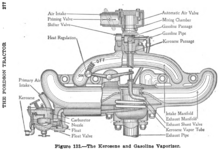
Internal combustion engines can be configured to run on many kinds of fuel, including gasoline, kerosene, tractor vaporizing oil (TVO), vegetable oil, diesel fuel, biodiesel, ethanol fuel (alcohol), and others. Multifuel engines, such as petrol-paraffin engines, can benefit from an initial vaporization of the fuel when they are running less volatile fuels. For this purpose, a vaporizer (or vaporiser) is placed in the intake system. The vaporizer uses heat from the exhaust manifold to vaporize the fuel. For example, the original Fordson tractor and various subsequent Fordson models had vaporizers. When Henry Ford & Son Inc designed the original Fordson (1916), the vaporizer was used to provide for kerosene operation. When TVO became common in various countries (including the United Kingdom and Australia) in the 1940s and 1950s, the standard vaporizers on Fordson models were equally useful for TVO. Widespread adoption of diesel engines in tractors made the use of tractor vaporizing oil obsolete.
References
- Beale, Paul; Partridge, Eric (2003), Shorter Slang Dictionary, Routledge, p. 60, ISBN 9781134879519
- "American Heritage Dictionary". Answers.com. Retrieved 8 October 2017.
- "Online Etymology Dictionary". Etymonline.com. Retrieved 8 October 2017.
- "Carbueetoe". Google.com. Retrieved 8 October 2017.
- Inventors and Inventions. Marshall Cavendish. 2008. p. 91. ISBN 9780761477617. Retrieved 19 January 2014.
- Webster's Revised Unabridged Dictionary, 1913
- Eckermann, Erik (2001). World History of the Automobile. Society of Automotive Engineers. p. 276. ISBN 978-0-7680-0800-5.
- Carlisle, Rodney (2005), Scientific American Inventions and Discoveries: All the Milestones in Ingenuity—From the Discovery of Fire to the Invention of the Microwave Oven, John Wiley & Sons, p. 335, ISBN 9780471660248, retrieved July 27, 2014
- Rigden, John S.; Stuewer, Roger H. (2009). The Physical Tourist: A Science Guide for the Traveler. Springer. ISBN 978-3-7643-8933-8.
- "Donát Bánki". Scitech.mtesz.hu. Archived from the original on 17 July 2012. Retrieved 19 January 2014.
- "Inspirator and Pulverizer".
- Eckermann, Erik (2001). World History of the Automobile. Society of Automotive Engineers. pp. 199–200. ISBN 9780768008005. Retrieved 2016-05-09.
- Sessler, Peter C. (2010). Ultimate American V-8 Engine Data Book (Second ed.). MBI. p. 228. ISBN 9780760336816.
- "Rockauto online auto parts catalogue". Rockauto.com. 2010-12-17. Retrieved 2011-01-01.
- Aumann, Mark (11 January 2012). "NASCAR takes 'really big step' with fuel injection". Nascar.com. Archived from the original on 25 October 2012. Retrieved 19 January 2014.
- Hillier, V.A.W.; Pittuck, F.W. (1966). "Section 3.6". Fundamentals of Motor Vehicle Technology (Second ed.). Hutchinson Educational. ISBN 9780091107116.
- "1952 Oldsmobile prestige brochure" (PDF). wildaboutcarsonline. Archived from the original (PDF) on 2016-03-04. Retrieved 2016-05-09.
- "1952 Buick Airpower folder". Oldcarbrochures.com. Retrieved 2016-05-09.
- Hibbard, Jeff (1983). Baja Bugs & Buggies. HP Books. p. 24. ISBN 0-89586-186-0.
- Carburetor#Principles
- Stermer, Bill (2002). Harley-Davidson Motorcycles. MotorBooks International. p. 154. ISBN 978-1-61060-951-7.
External links
- What is carburetor? Explain types of carburetors in I C Engines Carburetor and its types
- Simple carburetor working, diagram and limitations Simple carburetor working, diagram and limitations
- Solex Carburetor construction, working, and advantages Solex Carburetor
- Gasoline injection system Vs Carburetor System Drawbacks of the carburetor system
- General information
- Packer, Ed (July 1953). "Know Your Carburetor – what it is, what it does". Popular Mechanics. 100 (1): 181–184.
- American Technical Society. (1921). Automobile engineering; A general reference work. Chicago: American technical society.
- Lind, W. L. (1920). Internal-combustion engines; Their principles and applications to automobile, aircraft, and marine purposes. Boston: Ginn.
- Hutton, F. R. (1908). The gas-engine. A treatise on the internal-combustion engine using gas, gasoline, kerosene, alcohol, or other hydrocarbon as source of energy. New York: Wiley.
- Patents
- U.S. Patent 610,040 — Carburetor — Henry Ford
- U.S. Patent 1,204,901 Carburetor Antoine Prosper Plaut
- U.S. Patent 1,750,354 — Carburetor — Charles Nelson Pogue
- U.S. Patent 1,938,497 — Carburetor — Charles Nelson Pogue
- U.S. Patent 1,997,497 — Carburetor — Charles Nelson Pogue
- U.S. Patent 2,026,798 — Carburetor — Charles Nelson Pogue
- U.S. Patent 2,214,273 — Carburetor — J. R. Fish
- U.S. Patent 2,982,528 — Vapor fuel system — Robert S. Shelton
- U.S. Patent 4,177,779 — Fuel economy system for an internal combustion engine — Thomas H. W.
- G.B. Рatent 11119 — Mixing chamber — Donát Bánki
| Wikimedia Commons has media related to Carburetors. |
